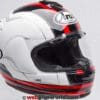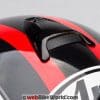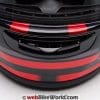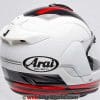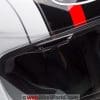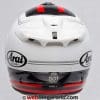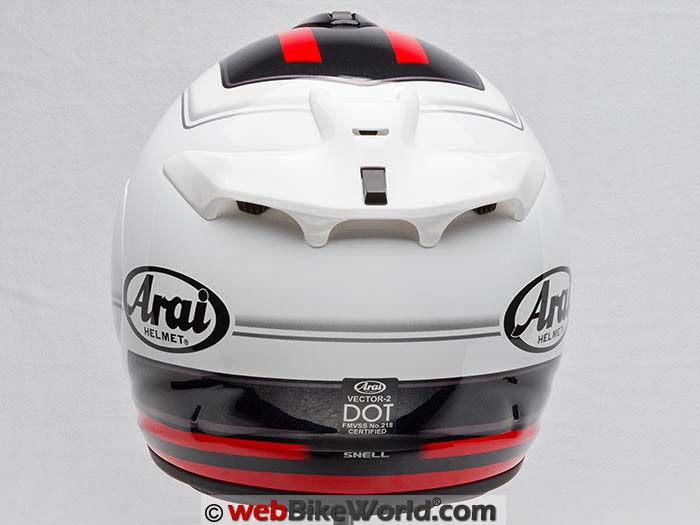We first reviewed the Arai Vector 2 in February of 2011.
At that time, the Vector 2 was a brand-new update to the original Arai Vector (review) of 2007.
The Vector 2 has the Arai “Intermediate Oval” internal shape; i.e., what we call “Neutral” to “Slightly Narrow”.
The Vector series has remained as one the most popular Arai helmets through the years.
It’s also one of the least expensive Arai helmets available.
The Vector 2 is the very definition of an all-around, street/sport/touring helmet.
It is getting a bit long in the tooth, as they say, and hopefully a Vector 3 is on the horizon.
Maybe at this year’s AIMExpo in October?
In the meantime, since it’s been 5 years (Wow!) since our original Vector 2 review, we thought we’d take another look, this time from a rider’s perspective, with this webBikeWorld “Owner’s Report”.
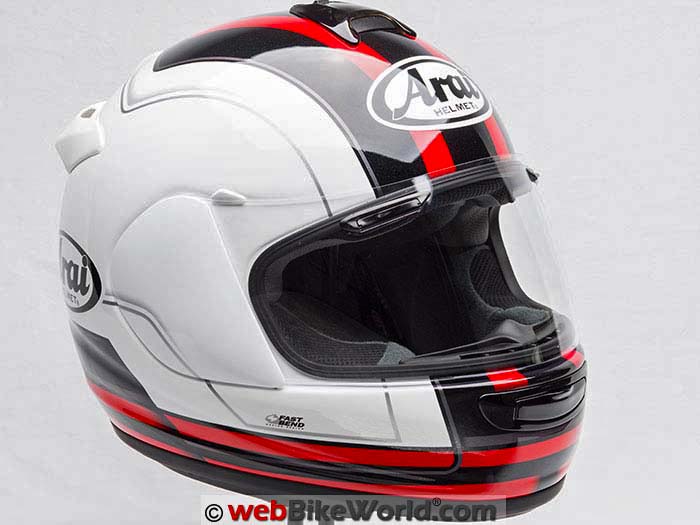
Introduction
The following is not a complete in-depth review, as Bill C. did that in an excellent review of the Arai Vector 2 back in February of 2011. For the complete details and more photos, I suggest you refer to that review.
Instead, I’m taking a look at the Vector 2 to offer my own perspective of using the this helmet from a rider’s perspective; i.e., a webBikeWorld Owner’s Report.
It might surprise you that a manufacturer will produce the same helmet design for such a long time.
Some helmet manufacturers release updated and new designs every couple of years but Arai isn’t most manufacturers.
Arai is considered as a top tier helmet manufacturer for a reason. Their helmet designs are carefully developed and just as carefully evolved and they also say that the helmets are hand made.
When you make helmets this way, you have to really make sure to get it right, so making changes just for the sake of change doesn’t fit the Arai model.
Plus, there’s the old adage “If it ain’t broke, don’t fix it”, something that makes sense here. Arai does innovate but at a more deliberate pace than other manufacturers.
With all that said, it might be easy to infer that I think all is perfect with the Vector 2 but that’s not quite so, I’m afraid.
I doubt the “perfect helmet” exists really, but as with anything, some things are subjective and others objective so let’s see how these bear out in my experience with the Vector 2.
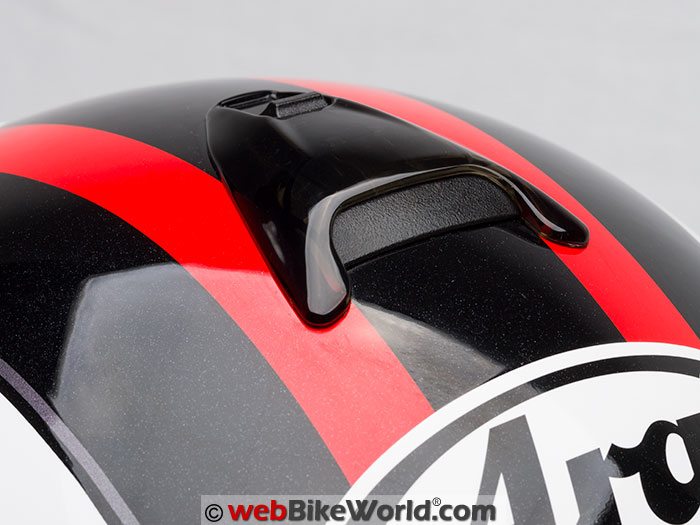
Paint, Graphics, and Overall Quality
Not much has changed since Bill’s original review in relation to the quality of the paint and finish on the Vector 2.
In fact, I cannot recall handling a helmet better than this one. Not a defect can I find anywhere on the surface and if you’ve read any of my webBikeWorld reviews, you know I look for those little details.
As Arai’s “bread and butter” helmet, the Vector 2 has always been available in a huge variety of colors and patterns over the years.
The graphic on this helmet is a new for 2016; it’s called “Stint” and it is available with yellow highlights or with the red color shown here.
The Stint graphics are not elaborate, but I like the more understated look with the large areas of white. It provides good visibility while having a nice accent.
Looking closely at the paint shows a lot of metalflake which is, in my opinion, super slick.
It is most noticeable in the black and gray areas of the helmet but it is present in the white as well. This leads me to believe the “flakes” may be in the clearcoat layer.
The paint is beautiful no matter how you look at it.
Picking up the Vector 2, one gets the sense this is a quality piece of protective equipment and not just a “brain-bucket”.
The fiberglass laminate which makes up the shell of an Arai is hand laid and the care that goes into shows. The shell is light but very strong. Not a creak or squeak is heard when trying to flex the helmet such as pulling it onto the head.
Overall, the shell feels extremely rigid when you try to flex it, which may be attributable to the Snell M2015 certification.
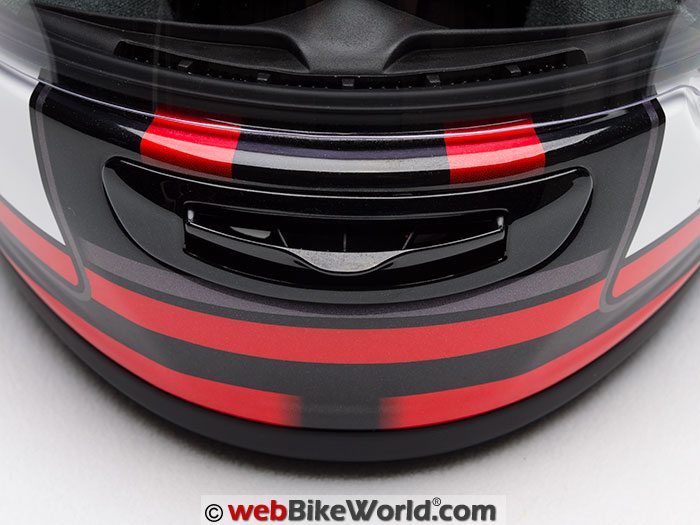
Liner, Cheek Pads and Padding
Looking inside the shell, there are areas where the unfinished shell interior is visible and the unsmoothed glass fiber texture under the black interior paint can be seen.
I like how Arai left it this way on the inside; it lends itself to their “less is more” philosophy.
Finishing the interior shell so it would be smooth probably doesn’t add any significant safety or comfort function, so why do it?
The vents and face shield — and the brow vents in the face shield for that matter — all operate positively and smoothly and this contributes to the overall quality feel.
In fact, I would rate the overall quality outstanding except for one issue.
I removed the cheek pad on the left side (a nice upgrade from the original Vector) to install mySena 10U intercom (review).
The cheek pads in the Vector 2 have a small triangular pocket located where the chin curtain, cheek pad and neck roll meet towards the front.
The pocket holds a plastic tab from the neck roll and when the cheek pad is removed, the tab tends to pull as it is unhooked.
The lower neck roll has a plastic base that is attached to the inside of the shell with a thin bead of adhesive.
When I first removed the cheek pads, this plastic came detached on both the left and right sides. The one on the left was easily placed back in position and the adhesive held it fast, but the right side didn’t.
This became a bit of an issue even after reinstalling the cheek pads, as the absence of “sticky” meant the left side piece wouldn’t seat correctly.
I removed and replaced the left side a few times just to confirm that it would still stick even after being separated and it did, but the right side didn’t.
Nowhere in the owner’s manual does it mention removing the lower padding.
Perhaps you’re not supposed to remove these parts, but it seems rather difficult to remove and replace the cheek pads without doing so.
I contacted the webBikeWorld Editor and he reached out to Arai for advice on what to do. They suggested replacing the adhesive if we could find something that would work.
I actually do keep some high quality 3M double-sided mounting tape on hand for when I move my headset from one helmet to another and this stuff did the trick very well.
The good news is that since that time, it has not caused any further trouble.

Vector 2 Helmet Internal Shape and Fit
I will speak to how it fits me, however and the overall comfort.
The Vector 2 has a larger bottom opening than many other helmets I’ve tried on, or it at least feels so.
This is probably one of the reasons it’s so popular; it’s not a race fit, but designed to be more comfortable for everyday use.
This large opening for the head is fortunate, because as I mentioned earlier, the shell strongly resists flexing.
Pulling the helmet down over my head, I was treated to the plush feel that other owners of an Arai lid know well, because the liner material is very soft and feels great against the skin.
I was worried that I may have ordered one size too big — or was it just that comfortable? But more on that in a minute.
The Arai “Intermediate Oval” shape works well for me. I tend to fit in helmets that are slightly narrow to intermediate in shape.
The only issue that I had with the Vector 2 shape is that the chin bar is pretty close to my chin. If I jut my chin forward I can contact the back of the chin bar with my very short beard and this is a little close for comfort for me.
Grabbing the helmet and pushing it towards my face from the front doesn’t quite feel like I can get it up against my chin, but it’s close.
In the event of a crash, I’d be a little concerned.
Of course this is how it fits me and maybe I would do better with one of the “longer” Arai shapes?
As with most Arai helmets, eyeglasses and sunglasses are easily inserted when wearing the helmet, which is good, as there is no internal sun visor available on any Arai helmet.
This is because Arai wants to provide maximum “crush zone” space at the forehead and an internal sun visor takes valuable internal space.
Also due to this, as far as we know there are no motorcycle helmets that are Snell M2015 certified that have an internal sun visor.
I mentioned feeling like the Vector 2 might be one size too big when I first tried this size large. I normally wear a size large in many brands, including Shoei, Scorpion, and Shark and they all fit snug and secure.
In some brands — like HJC — a size large fits but it is more loose or relaxed than I prefer.
The Vector 2 is somewhere in between for me. Because of this concern I did a little online research and that turned up some videos that Arai has published on how to properly fit their helmets.
After watching these and taking the helmet on and off, I believe I might actually be better served by a size medium and modifying the cheek pads using the peel-away padding. Or, I may need thicker cheek pads for this size large.
If you are between sizes, Arai offers liners and cheek pads in different thicknesses to help customize the fit.
Keep in mind that helmet fit is a very subjective thing since everyone’s shape, size and comfort level are going to be different.
I think that once you find the correct internal shape — as I feel the Vector 2 is for me — then a little time spent trying on different head sizes and using the provided customizing options on the padding should result in an excellent fit.
More information on helmet fit can be found in the webBikeWorld Motorcycle Helmet FAQ page.
Also, be sure to check out the chart that lists the helmet weights of webBikeWorld reviewed helmets and also by shape on the webBikeWorld Motorcycle Helmet Shapes page.
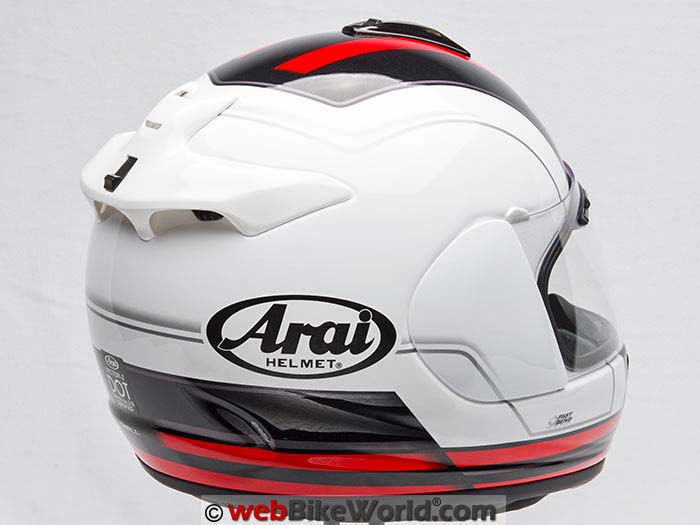
Eye Port and Visibility
The horizontal side-to-side view out of the Vector 2 has to be one of the best I have experienced.
The edges of the eye port are easy enough to see if you move your eyes but when looking forward, there is little, if any, of the periphery of the eye port visible.
The vertical sight lines are also very good but not the same extensive view I had in my Shark Vision-R GT Carbon.
Still, I appreciate the very good, not-so-extreme upward angle of view afforded by the Vector 2, as the Shark could be problematic at certain times of day when the brow of the helmet couldn’t be employed to block the sun.
Part of the reason the Vector 2 offers such a wide angle of view isn’t due to the size of the face shield and its opening.
In fact, I measured the size of the opening and compared it to my Shark Speed-R helmet and the Arai opening is smaller in both the vertical and horizontal planes but the Vector 2 offers a wider view in both.
The Shark helmet is no slouch offering a good view, but the Arai helmet shape puts my face about an inch closer to the visor.
This amount will vary, depending on the shape of the wearer’s head.
But it still makes a huge difference in the angle of view out of the eye port while keeping the eye port opening relatively smaller, which helps to make the helmet shell stronger.
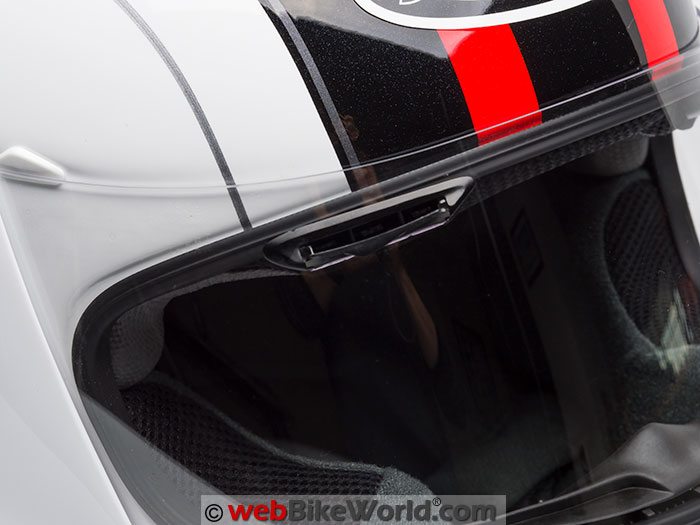
The Vector 2 Face Shield
Optically, the face shield is as good as the best with very little (if any) distortion of the outside world in your view.
This doesn’t surprise me really, because Arai is a premium brand helmet manufacturer.
But there is something I do find surprising: opening and closing the face shield is accomplished using a small tab on the lower left side that clicks securely into place when closed.
The face shield doesn’t have multiple detents, so it can be raised to almost any position and it will stay there at most street legal speeds. For the track, I’d leave it closed and locked however.
Arai seems to have a reputation for having an awkward or at best a “not user friendly” system for removing and re-installing the face shield.
In Bill’s own review, he stated that he didn’t try to remove the shield for fear of broken side plates that others on the wBW crew have experienced.
I’m not sure what’s wrong with me but I went ahead, read the instructions, and decided I’d go for it and remove the face shield.
Removal is actually pretty easy, but it doesn’t sound particularly pleasant.
Still, I had the shield in my hands and was feeling triumphant and scared at the same time knowing I’d have re-install the clear polycarbonate crescent now in my hands.
In Bill’s full review he linked to a video showing someone who somehow can pop these visors on and off quite easily, making it look as easy as breathing.
I watched this video and I am still fascinated by the rider’s ability to swap the face shield on and off and it is completely incongruent with my experience.
I took my time and studied the shapes cut in the visor as well as the tiny view I had of the details behind the side plate.
After a couple of false starts, I was able to get one side installed securely. The other side would elude me for a while.
After several “this side or that side” installations I was able to get the face shield back in place.
The entire process took 2 to 3 minutes the first time. Subsequent attempts to re-install took only 10 to maybe 15 seconds of being careful and slowly guiding all the pieces together.
I feel competent to change these out without fear of breaking a shield (mostly), but the previously mentioned video might push some people over the cliffs of insanity. It’s inconceivable!
With all that said, I personally don’t swap out a face shield very often unless it is damaged or needs a better cleaning than I can give with it installed.
However, if you prefer to swap out to a tinted face shield very often, this could be a deterrent.
Note that on the newer Arai helmets, like the Arai Corsair-X (review), Arai is now using a completely redesigned face shield attachment and removal system. As new Arai helmets are designed and released, we expect this system to be included.
Also, although Arai does not offer an internal sun visor in their helmets, they do offer Pinlock-ready face shields as well as the Arai Pro Shade (review) external sun shade.
Either option requires replacement of the original face shield (at least with the Vector 2), so the cost of a new face shield will add to the cost of the helmet.
The Arai Signet-Q Pro Tour (review) and the Arai Defiant Pro Cruise (review) come with the Arai Pro Shade.
Vector 2 Ventilation
The Vector 2 offers the standard array of vents one would expect to see on a modern motorcycle helmet.
A chin vent, top vents and rear exhaust vents are simple holes in the shell, while a pair of drop-down brow vents are located in the face shield.
The Arai brow vents consist of small, two-position tabs that allow air to flow through the shield and into a port in the surround of the eye port.
On the inside of the helmet this port is covered with the fabric from the liner. It makes for a nice clean look on the inside but the fabric seems to slow and diffuse the air.
I think it reduces the effect of these vents quite a bit. If I turn my head, I can feel some air flowing through these vents but when facing forward the air flow is very subtle.
The chin vent flows a lot of air, period.
It has two openings but the difference between the two is not that striking. What is striking is how the air from this port blows right into my mouth.
This might vary a bit depending on your head shape, but so much air is blowing right onto the lips is a bit distracting.
After a minute or so on the highway I just closed the vent. Even half open it gives quite a bit of air and since there is no chin curtain provided, plenty of air flows up from below.
I suppose I can’t fault the vent for flowing so well but the direct blast of it is a bit much for me.
The rear exhaust vent also has two positions in that it partially or fully exposes two holes in the rear of the helmet.
I am pleased to say that I could actually feel a noticeable difference in air flowing through the helmet with this rear vent open.
Most of the time, I can’t tell a difference if one of these rear vents is open or closed on most helmets I’ve worn. It is great to see this implemented in a way that works.
There is a slight bit of wind noise that appears when the rear vent is opened but it is not distracting.
The top vent of the helmet is another story. To start with, I want to say that the top vent, like the rear, works well and one can definitely feel air flowing over the top of the head.
When the rear vent is also open at the same time, the air flow is outstanding and overall I’d say the ventilation in this helmet is fantastic and in some ways even excess to requirement. Some of this air flow comes at a cost and that cost is noise, however.
Note that our helmet evaluations are a combined effort of several riders over time on different types of motorcycles with and without windscreens.
Evaluators wear correctly fitted, high quality ear plugs (even when evaluating motorcycle intercom systems).
Always protect your hearing when riding a motorcycle. See the wBW Earplug Reviews for more information on choosing and wearing earplugs.
Note also that perceived noise levels will vary, depending on the individual.
Noise can be caused by many factors, including helmet fit, the type of motorcycle and windscreen, wind speed and direction and even the rider’s clothing.
For more information on helmet noise, visit the wBW Motorcycle Helmet Noise page.
Arai Vector 2 Noise Levels
When I first rode with the Vector 2, I started off very pleased. The wide view was great and the plush interior really felt nice.
Also, this helmet has to be one of the quietest I’ve worn under the right conditions. I know that there are other helmets out there that may be quieter, but in my experience, the Vector 2 was very quiet, at first.
My Kawasaki Ninja 1000 (review) has an adjustable windscreen, with the lowest position really not making much change to air flow at my head.
The Vector 2, like many helmets, is quietest when it is pushing through clean, undisrupted air.
Raising the windscreen does induce more and more wind rushing noise but it is still well controlled and not distracting. I’d say the sound levels with the screen in higher positions is about average.
It still is mostly wind rushing noise and there is little “booming” or other lower frequency sounds that I noticed.
I tried out the Vector 2 while riding our BMW R1100R (which has no windscreen) and I found the noise levels to about the same or at least close enough I couldn’t pick out any differences.
While on that first ride, I started experimenting with the vents on the Vector 2 and was very surprised when I opened the top vent and it started whistling — not just a subtle sound, but it was rather distracting.
It also starts around 30-40 mph so most any time I’m riding on the street, the whistling is present when that vent is open.
Like other webBikeWorld reviewers, I wear ear plugs when riding and this whistling was still loud enough that I kept the vent shut.
I did try opening it a few times during some subsequent rides but always ended up closing it.
At this point, I looked at Bill’s Vector 2 review to ascertain if this was a one-off incident. It turns out that he experienced the same noise and in cases with a tall windscreen, the vent would generate a “duck-call” like sound.
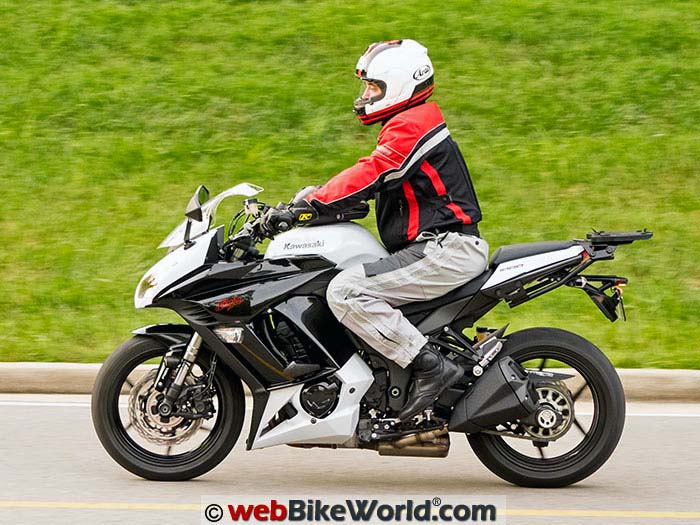
Conclusion
My first experience owning an Arai helmet has been somewhat of a mixed bag.
The build quality and finish are excellent and only marred by the strange adhesive issue with the lower padding. This was easily remedied but a bit disappointing for a premium helmet.
The view out of the eye port is fantastic and it rivals that of the Shark Vision-R (review), despite the Vision-R having a much larger eye port and face shield.
Positioning the face closer to the shield improves the view as well as reduces any “I’m in a tunnel” effect and it’s something I’d like to see other helmet brands try to mimic.
Of course, this may be due to the number of helmet shells used for the Arai vs. the Shark.
The comfortable interior makes the Vector 2 a great place to keep your head for hours on the road and the ample ventilation is outstanding when the weather is warm.
The fact that the helmet flows lots of air is helpful because you may need to keep the top vent closed for a peaceful riding experience.
Arai has an excellent reputation and they tend towards slow, methodical development. I hope the next Vector helmet includes a quieter top vent and the revised Arai face shield removal mechanism.
If it does, this helmet would be hard to beat at any price.
| wBW Product Review: Arai Vector 2 Helmet | |
|---|---|
| Manufacturer: Arai Helmets | List Price (2016): $499.95 to $649.95 |
| Colors: Solids and graphics. | Made In: Japan |
| Sizes: XS-2XL | Review Date: August 2016 |
| Shell Sizes: Unknown | |
|
Rating Scale is subjective: Unacceptable, Poor, Neutral, Very Good, Excellent, Outstanding.
|
|
Owner Comments and Feedback
See details on submitting comments.
From “S” (August 2016): “Thank you for the updated review! The only thing I can say is that I guess air flow is a matter of personal tastes, I could wish for more air in the mouth from my Arai while you hoped for less.
The only thing I truly wish to address is face shield removal: Why do journalists have such a difficult time understanding the system?!
Why do journalists always give Arai flack for the system when it is the easiest to use system in the industry??
To understand the system all you need to is to look at the shield while it is removed and in your hands. The side tabs are the same organic shape as your own hand if you hold your hand straight out and open the thumb only.
Think like that and understanding the tabs becomes easy.
When you have your hand out, 4 fingers together but your thumb open, imagine that you have to twist the pocket formed by your thumb around a stationary post. That is the Arai shield mounting system: a pocket around a post.
To remove the shield simply lift up the shield until the side levers appear.
While holding the levers all the way up, simply keep “opening” the shield. The shield will rotate completely off the shell, no muss no fuss.
DO NOT USE ANY OUTWARD FORCE. At no time does the Arai system need the shield pulled outward from the shell, all motions are ROTATIONAL.
This is what confuses non-Arai users, they are used to hodgepodge systems where you have to pull and push and rotate together. Arai is simply ROTATE ONLY.
To put the shield back on, it is time to imagine your hand’s thumb pocket.
You simply twist the shield tab’s opening, analogous to the thumb pocket (look, its the same shape!) around a (stationary) shield post.
Insert the shield onto the (hidden) post by starting with the shield in a “very open” (high on the shell) position and lever the “pocket” on to the post. Now it’s time to image the thumb pocket again.
If you stuck you thumb pocket around a post and tried to twist your hand around said post, the hand would rotate around the immovable object, the post in the thumb pocket. A completely “organic” motion.
Now duplicate that motion with your shield.
Place your hands on each side of the shield so that the shield tab’s opening (“pockets”), now hidden underneath the side plates, align with your own thumb pocket when your hand is held as described above (or somewhat close, but this placement will help you understand the mechanics of the movement).
While pushing the shield towards the rear of the helmet, in order to make sure the post remains set in the shield pocket during the movement, rotate your thumb pocket (and the shield simultaneously) around the (hidden) post.
A “back and around” motion centered on the post, again just as if you rotate your thumb pocket around an object. Done! You have just remounted your shield.
Completely organic, the shield moves just like your wrists.
On, off, same motion — rotate off, rotate on. Simple!!
Please practice a bit, and let’s try to finally kill off the old “Arai shields are difficult” wives’ tale in the future…I’m a bit saddened, and tired, of hearing it.
Arai shields are not a Shoei, not a HJC…they’re better! 🙂 So stop trying to mount your Arai shield like a Shoei, Arai’s mounting system is much more…refined.
You don’t pop, don’t squeeze and certainly don’t pull. Just rotate.”
Editor’s Reply: Actually I have no (or minimal) problems with the Arai system and have stated so. I guess you’re referring to our most recent article, which was written by a webBikeWorld contributor in the “real world”, not a “journalist”!
The new Arai system on the Corsair X (review and explained here) will be replacing the older system as Arai helmets are updated, so even Arai must feel the older system needs an update.
Their new system is easier to use but still clumsy, I must say, when compared to something like the Bell or HJC or Shoei system.
And I won’t mention the fact that any system that takes ~450 words to describe as above is probably a bit too complex! 😉
From “S.S.” (August 2016): “The owner’s report of the Arai Vector 2 very closely matches my own experience.
In my case, I had previously worn a Shoei helmet, but had never actually been properly fitted.
While attending the NYC show, I was able to be custom fitted for an Arai helmet, and the Vector 2 happened to be the model that fit my head shape best.
Suddenly wearing a helmet that actually fit correctly was not exciting as I expected, but rather boring, as I didn’t notice it at all when riding on long trips, quite a contrast from the excruciating pain that increased with each mile while wearing a helmet that didn’t fit me well.
I strongly encourage anyone looking for a new lid to find a shop that can fit a helmet properly — regardless of brand, you will be so much safer riding without the distraction that a painful helmet can create.
Now, getting back to some specifics about the Vector 2:
I, too, still struggle with the face shield installation. Removal is easy, although it sounds awful when you are doing it.
Reinstalling usually takes me several tries, and pivoting the shield down into place always feels like I am going to break something.
The shields themselves are very high quality, and I use the standard clear one as my fair weather shield, still treating the outside with Raincoat, and the inside with Clarity Defog It (review) for those occasional sprinkles.
I also carry a Pinlock shield, also treated with Raincoat, for those steady torrential rains where the Clarity just can’t keep up.
I did purchase the Arai shield with the external sun visor, and it was terrible on my particular bike, as the shaded mini section would randomly snap down at speed.
It was also a pain to clean, and began to leave a permanent mark where the mini shade touched the main visor. Price was ridiculous as well.
The other complaint I have about the helmet is the lack of screens in the vents, as I seem to collect a lot of bugs coming in through the vents, especially in farm country.
While the air flow is good, the lack of a chin curtain really raises the sound level inside, and I also get the whistle while riding my 95 Tiger which has a windscreen.
Overall, Arai makes a very high quality product, but they are very expensive and have their own quirks. Hopefully the next version will address some of these common issues.


